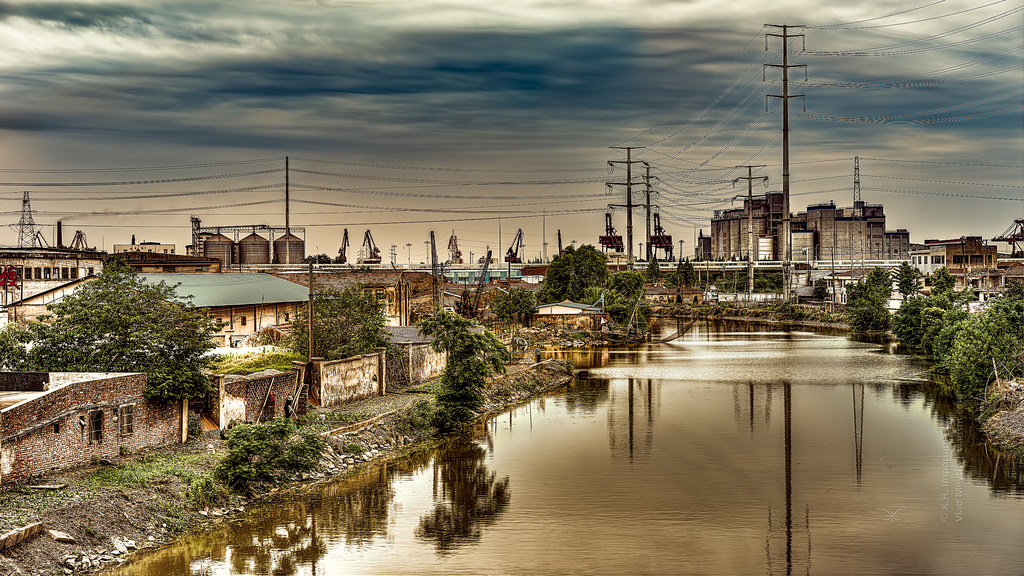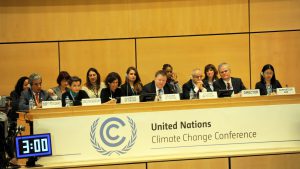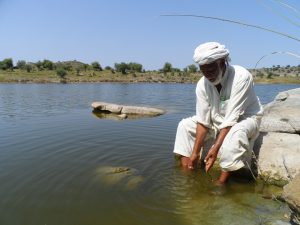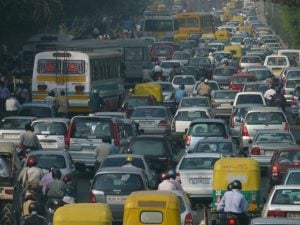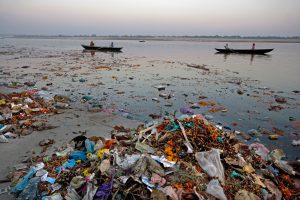Just as 2015 entered its final weeks, Beijing’s municipal government declared an air pollution “red alert” for the first time since the policy was established in 2013. The move typified a year when air pollution once again dominated environmental coverage, at home and abroad.
The announcement was sent out very late in the day. The entire city, including its officials, scrambled to make sense of the measures that had never been implemented before. People were asking: which kind of cars with what kind of plate numbers are allowed on the road tomorrow? (The government asked motorists to stay at home on certain days in an emergency bid to bring down car emissions).
To some extent, Beijing’s “red alert” experience epitomises China’s environmental journey of 2015: lots of good signals, with largely mixed results.
The sudden announcement that caught the entire city off guard (pollution levels were not nearly as bad as the ‘Airpocalypse’ episode days before) seemed to be the direct result of instructions from the top leadership, according to information released by the Ministry of Environmental Protection (MEP).
While this once again shows how responsive the current leadership is toward public sentiments, it also demonstrates the gap between intention and reality: it has taken the top leadership and repeated appeals from the Environment Minister to get China’s capital city to implement what is clearly written on paper.
Distinguishing between intention and reality is the key to a fair assessment of China’s 2015 environmental achievements. Too often, intentions are expressed loud and clear, whereas results are muddled and messy. A look at the country’s environmental scorecard this year will show that while well-intentioned policy declarations are not always “empty words”, it takes calculated, strategic efforts to translate them into actual progress.
The new environmental protection law
Laws often embody noble intentions. On 1 January 2015, China’s new Environmental Protection Law came into force amid high expectations. From the text of the law, observers both within and outside China could clearly sense the urgency with which the country was taking environmental issues.
Polluting companies will face fines without a ceiling; NGOs are welcome to initiate public interest lawsuits; and local governments will be held accountable for implementing environmental policies.
But the law has to navigate a reality that is defined by fundamental features of how governance in China is structured, which leads to unbalanced results. On the one hand, the law seems to enhance enforcement on the local level, largely by removing arbitrary and out-of-date limitations that bind the hands of local environmental protection bureaus (EPBs).
The new law authorises EPBs to fine violating companies on an accumulative basis, without a ceiling, which is a departure from the long-time practice of one-off fines capped to amounts that are trivial to most companies today. According to data released by the Ministry of Environment Protection, during the first eight months of new law’s implementation in 2015, there were 405 cases of “accumulative fines”, worth a total of 330 million yuan.
It means on average each case involved more than 800,000 yuan in fines, already exceeding the highest 500,000 yuan fine limit in the previous version of the law.
But like other measures in the new law that are meant to strengthen the teeth of local law enforcement, they are valuable when local authorities intend to use them.
When they don’t, neither the central government nor the public has effective ways to compel them to enforce the rules. The new law aims to change that by including accountability clauses for government officials. But so far result in this area is unclear.
A recent review states that the “sleeping beauty” phenomenon (when laws and regulations never get activated) is still a widespread problem on the local level.
Moreover, law enforcement is often driven by the “personal interest and temperament” of the officials, which tends to further complicate the problem.
Similarly, despite a strong push to encourage public interest environmental lawsuits by NGOs, so far only 36 such cases have been brought to court, which is dwarfed by the number of pollution incidents and violations that are actually happening all over the country. Interference from local government is still considered a reason why courts hesitate to accept such cases.
Peaking carbon emissions
This year was also marked by increasing detail and engagement from China on the country’s efforts to stabilise the global climate. Following a ground-breaking announcement in November 2014, that China would peak carbon emissions by 2030, this year the Chinese government further elaborated on this target, by proposing a fairly ambitious carbon intensity goal and a timeline for a nationwide carbon trading system. These commitments from China made a big contribution to the successfully negotiated Paris Agreement on 12 December.
Climate change is an example of where the intention of China’s top leadership matches well with reality on the ground. For one thing, the Chinese economy is already undergoing significant changes that put downward pressure on demand for coal, China’s single biggest source for primary energy. These changes include a shift away from heavy industries, such as steel and cement, towards higher energy efficiency.
In January, China recorded a drop in coal production for the first time in this century, a trend that many say will be irreversible. Latest data released by the Chinese authority suggests that the decline of coal output is continuing. China’s resolute battle against air pollution is also a major risk to China’s production and use of coal, and such issues became increasingly seared on the public consciousness this year in light of the environmental documentary “Under the Dome,” made by former CCTV journalist Chai Jing.
The instant popularity of the documentary released in February, 200 million clicks in a matter of days, underlined the depth of public concern on the air pollution issue. Notwithstanding the somewhat perplexing fate of the documentary afterward, the strong signal sent by the public reaction did create more urgency and political momentum. More stringent measures against coal were put in place later in the year. Such factors all indicate that China’s carbon pledges have a solid foundation.
See also: Will China’s environmental law help to win ‘war on pollution’?
The new minister and his reforms
When China appointed its new Environment Minister at the beginning of this year, it was hailed internationally as a wise move. For the first time an established environmental scientist holds the country’s green gavel. As soon as he stepped into his new role, Minister Chen Jining made it clear to the nation that reforming the Environmental Impact Assessment (EIA) system would be at the top of his agenda.
China’s EIA system has long suffered from being a rubber stamp. Loopholes in the system have also encouraged rampant rent-seeking. Those EIA agencies affiliated with the Ministry of Environment Protection (MEP) or local EPBs enjoy popularity among those who seek to have their projects approved.
Government officials sat on the boards of EIA firms, creating a clear conflict of interest, while companies that were overseen by the MEP also had shares in companies carrying out assessments. This served to guarantee “green lights” for projects that all too often were flawed in their design or were clearly detrimental to the environment.
The huge blasts in Tianjin on 12 August that killed 173 people and injured hundreds of others illustrated the deadly consequences of shoddy gate-keeping.
In that instance however, the EIA only played a partial role in a string of fateful decisions that allowed the dangerous warehouse to operate in the vicinity of a densely populated neighbourhood.
Minister Chen vowed to clean up the EIA system by first severing the link between his ministry and its affiliated EIA agencies. So far, results look promising: six prominent EIA consultancies have transformed into privately owned companies and two have completely given up their certificates to provide EIA services.
But for Mr Chen, this is an easy task to start with. After all, those EIA-related agencies all fall under the ministry’s leadership, and therefore have to follow the directives of their big boss. The true test would be pushing the reform into provinces, where local governments have more incentives to keep such affiliated agencies under their control.
What’s even more challenging is the MEP’s initiative to further embed EIAs into the country’s decision making process, especially in the early planning stages, where blueprints of entire regions are being drafted. A new regulatory agenda, unveiled in October, included the revamping of China’s EIA Law and its Planning Environmental Impact Assessment (PEIA) regulation.
But such initiatives would have to overcome resistance from departments that are traditionally in charge of planning, and are accustomed to treating environmental impacts as an afterthought. They are often not bound by directives from their environmental colleagues.
In this regard, the MEP has made a smart move by harnessing the political shockwaves of the Tianjin accident. In October, the ministry dispatched numerous teams to check the integrity of PEIA processes of major chemical installations all over China, as a way to boost the status of PEIA in the political agenda.
Conservation
The past 12 months was also a big year in efforts to protect endangered species. In May, China implemented a crackdown on ivory trade. In a matter of months, the country increased the intensity of its response from an import ban to a nationwide ban on trading products. A presidential commitment to eliminate the ivory trade was a further attempt to buttress government efforts.
According to a recent investigation by conservation groups, those measures appear to have cut ivory prices in the Chinese market by half, indicating a weakening demand for products that are driving elephants towards extinction in many parts of Africa. It is an example of how effective awareness campaigns combined with measures to save endangered species, are able to curb consumption.
The growing Chinese middle class and its demand for products, ranging from fireflies to pangolins, just to name a few, is a reality that every serious conservation campaign should address.
The panda’s fate in 2015 depicts a much more complex picture. Despite new data reported in March showing the total number of wild pandas is growing, the trend of increasingly fragmented communities is more disconcerting to conservationists. Later in the year, we saw reports showing the habitats of pandas threatened by questionable “forest regeneration” projects. The challenge faced by panda, a national symbol and an element in Chinese diplomacy and ‘soft power’, exemplifies the difficulty in bridging intention with reality.
The plight of China’s most cherished animal highlights the importance of addressing the fundamentals underlying the country’s ecological crisis, including: proper ownership regimes for natural resources; science-based spatial planning that ensures the integrity of ecosystems; and a strong governance system that make sure policies are honoured on the ground.
All these elements are included in the recently announced, grand “Eco-civilisation” initiative from the top echelon of the Party. Putting those concepts into practice will be another huge task for the country’s environmental policy makers and practitioners.
Cleaning up water and soil
China also made headlines this year by releasing a “10-point water plan” in April that contains many far-sighted measures against widespread water pollution in the country. It is believed that a similar soil plan is also in the making. What is interesting about the 10-point plan is that for each action point, a leading ministry and its supporting ministries are clearly assigned.
This could be the policy-makers’ way to overcome bureaucratic buck-passing that is characteristic of the Chinese system. Given the current disciplinary pressure on the Chinese officialdom, this trick might actually work.
For many years, people have been talking about a potential “turning point” in China’s environmental trajectory.
With air pollution in China showing signs of mild improvement and a carbon peak almost in sight, there are reasons to believe that Chinese society might be at a tipping point of fundamental environmental transformation.
The ironic thing is that the tipping point, where every problem seems to be at its worst, is also the most uncomfortable place to be at right now.
